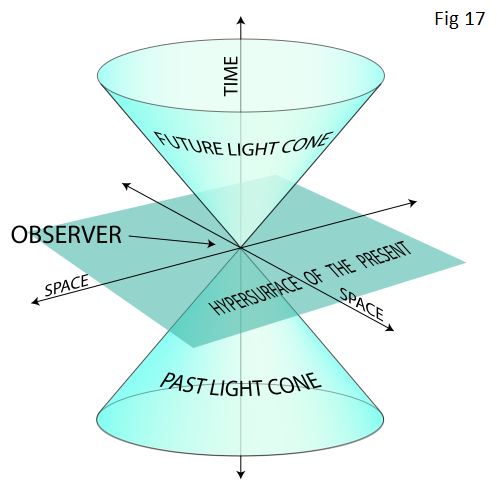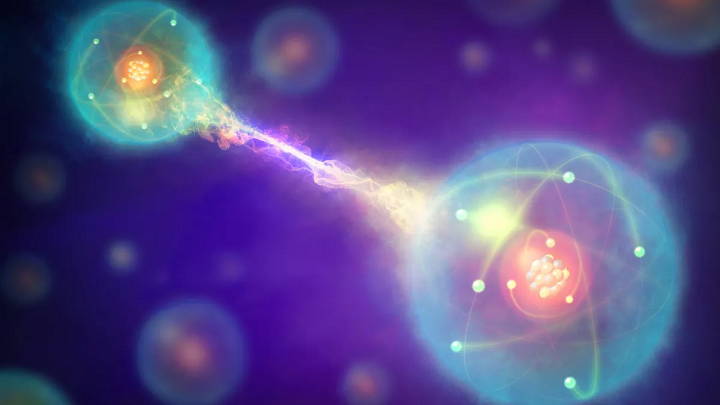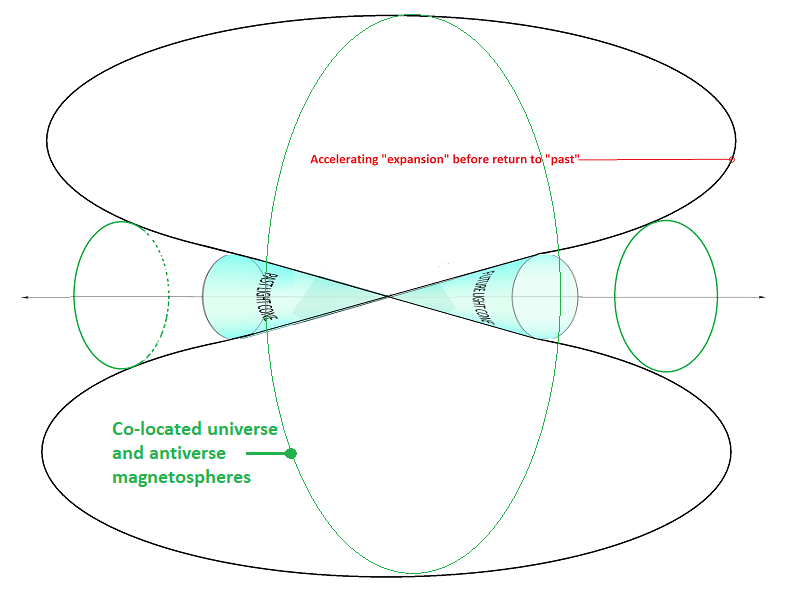Further observations about physics – split files
(21) Entanglement with our past
Look at the light cone diagram again and note how a 3-dimensional universe is represented as a 2-dimensional disc/sheet.

Entangled particles, I propose, are very frequently (if not over-ridingly) situated across the past/future disc interface. I also propose that the future light cone could well be virtual because the entangled particles/atoms/objects are entangled with their opposite (anti-versal)
magnetospheres. These "spheres" are the stage upon which particles dance. As I have suggested (and if this eventually proves right) electrons/positrons – and then all other particles) are "formed" by an oscillating pair of photons that are “made” of expanding and contracting spatial
spheres that are subject to a rectification process that leaves the "down the plughole" contracting part of the "rectified" oscillation looking like point sized particles (note the "1/2 spin" of many particles). Any movement of these particles results in them moving away from this vortex point
towards the periphery of this 2-d disc that really represents a 3-d environment. As we move the particle faster and faster, it drags the anti-versal, entangled particle and its mirrored anti-verse with it. This sits nicely with dark matter and we possibly see this ability of the
antiveral/universal magnetospheres to increase their separation from each other (Nb, when small colliding galaxies appear to pass through each other, they leave their dark matter halos behind near the crossover point).

The speed of light limit is set (à la Maxwell) by the interaction of the "universal" magnetosphere with the "universal electro-sphere" (albeit that the latter is apparently a series of point like "particles"; the points are where they are disappearing down the universe to anti-verse "plughole" – or "vortex"). On the other side, the limits are the same but with time (entropy really) running in the opposite direction – from the universal point of view. Note that the universal and anti-versal magnetospheres are extremely large and, in all probability in my conception, they eventually come to rest on the distant margins as a co-locational whole. It is only the electro-spheres that are apparently widely separated (by an entanglement "tunnel"). There is probably no SoL limit up and down this tunnel, for the tunnel leads to a mirror image particle and, probably, a mirror image anti-verse, the properties of the entangled pair across the divide are also a mirror image. So the properties and commitments of the particle/antiparticle pair are fully predictable and determinate when one or the other is interacted with. The speed of light is entirely determined by the of emission from electron shells (etc) and the speed of approach to a distant shell. (Nb, it is now restored to a velocity). It doesn’t matter how fast a particle is travelling, absorption and emission of light both leave and arrive at orbital shells at the SoL. Relative changes in movement between them are accommodated by increasing or decreasing the emission or the absorption frequency (or both). The velocity of the oscillating photonic pair across the electron/positron divide needs to be superluminal and at its maximum velocity close to the electro-spheres. This slows to a halt as the universal and anti-versal magnetospheres coalesce. The anti-versal electro-sphere is centred around a place (a set of spatial – distance – co-ordinates) that we passed through in our past. However, à la Einstein, the anti-versal positron sees us to be in its past while the universal electron sees the anti-versal positron to be in its past. As we try to accelerate a particle (by definition it is entangled with an anti-versal partner), we accelerate away from the point like entry into the vortex (entanglement tunnel) and that means "dragging" the anti-verse behind us. As we get close to the SoL it becomes increasingly hard to “drag along” and our mass increases exponentially.
As I have mooted earlier, the basic “elemental” particle pair are probably the electron/positron pair. All other particles are probably generated “along the entanglement tunnel” further towards the anti-versal component than the electron. (See – previously). Although time (as anti-versal distance) appears to us to be one dimensional, this is probably due to the illusory foreshortening of the entanglement tunnel distance, from the electron to the positron (due to a superluminal interconnection – like looking through a telescope). And, once at the “end of the tunnel” the 3-d anti-versal dimensions will seem exceedingly shrunken from our perspective. But time is probably 3-d for all that – it’s just that we can’t appreciate it from this distance. Remember, the past is a place – it is where we were on the universe/galactic/solar system location say, for example, 25 years ago. We have left our anti-versal ghost there (and, of course, it’s all inverted from the anti-versal perspective with time – entropy really – appearing to us to be running in the opposite direction).
So, now we can switch attention to the large scale expression of this time-toroid structure. I have spent a while considering the electron-positron pair. However, the same basic structure is likely to underlie the universe to antiverse wormhole across a whole galaxy (or groups of galaxies) with the mouth of the black hole representing the wormhole tunnel entrance. The antiversal partner, in this instance, may be massively distanced from its entrance; indeed, this could subtend to the the "distance" from big bang to black hole. From our perspective this is close on 14 bn years. However, from the event horizon's perspective it will be far shorter as clocks there would run very slow. It could be that this tunnel represents the big bang to black hole "lifetime". As time runs very slowly at the event horizon, very little time will have passed from the "big bang" and each event horizon should perceive itself to be closer to all the other primordial black holes and the big bang and that is unlike how we interpret it. Another point is that we can extend the time cones of the first diagram. This is a schematic diagram as the confluent encompassing magnetospheres would be massively larger that this diagram suggests. But this is enough to show that, if the "time" component of spacetime is looped, we should have an impression that spatial enlargement will appear to accelerate as the universe and antiverse magnetospheres begin to converge with each other and spacetime reduces to all space and no time.

Earlier in this section, I implied that the future may be more illusory that real. It could be that we are effectively "at the pole" of time and that the future is virtual but the past is real – if we continue to look at the past as a pysical spatial address in the universe (of course this is relative to all other matter and its history).
It is difficult to conceptualise how a mirror image antiverse exists and in what form (virtual/real). However, to me, all the clues point to this being an explanatory entity and the ubiqitous presence of dark matter adds "real" (vs imaginary) weight to the idea.
[Fortuitously, just as I had finished this section, Quanta magazine published this article showing a "double metronome". This is a useful video for "mental manipulation". Imagine splitting the double metronome vertically down its middle and then separating the two halves. That crossover separation is analogous to the wormhole tunnel that I am proposing. The actual situation would be that the largest angle the arms subtend to would represent the maximum reach of the expanding magnetic bubble. But, in the universe there would be myriad, very large bubbles in different phases (that would average each other out and also add up to create an overall larger and more constant volume). The discrete isolated crosssovers would, however, remain well defined although scattered around. So, what we would "see" is the two "collapsing" arms (bubbles) emerging out of the surrounding magnetic mist and becoming ever more sharply defined as they get closer to the crossover. Eventually, we will simply "see" a focal sawtooth of disappearing half bubbles (arms). The SoL Maxwellian stage of each half is possibly related to the extent of the bubble expansion and the crossover frequency.
This helps us to go back and think around the light cones (first diagram here). The centre piece of the metronome coresponds to the apex of each light cone – their crossover. The entropy gradient will appear to run back towards the cone apex/crossover for gravitaional entropy and outwards along the expanding light cone for photonic entropy (radiation escapes into the deeps voids of space and becomes massively red shifted). It is the gradient of entropy increase that gives us an impression of the direction of time. Would it be legitimate to infer that electromagnetic waves can/do travel" backwards in time"?]